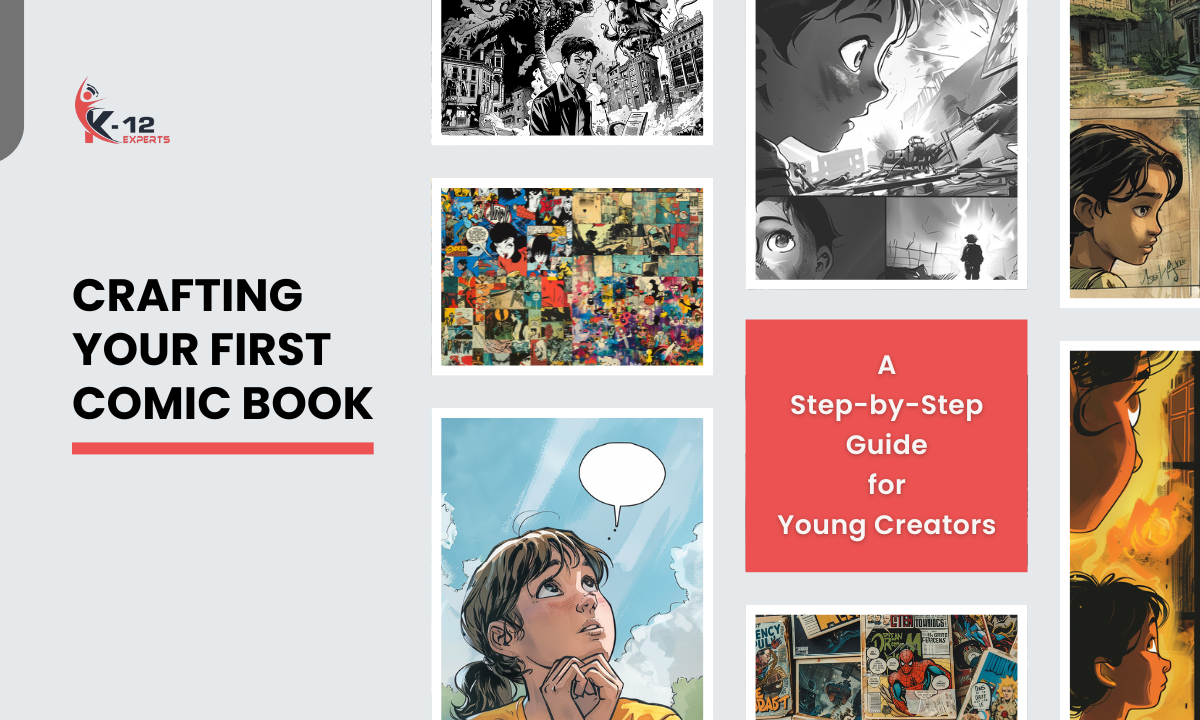Plunge into the exhilarating adventure of crafting your very first comic book, where you’ll discover that the blank page is your new closest companion, not an intimidating abyss. Start by journeying on a creative quest across various genres and styles, armed with nothing but your reliable sketchbook, capturing inspiration from the world’s quirks and wonders. As you shape characters with the depth of the ocean and personalities as vibrant as a sunset, you’ll find them becoming almost like quirky friends you can’t wait to hang out with. Plotting your story, envision weaving a tapestry where each thread is a twist and turn, hooked around the theme’s compass, guiding your characters through their trials and triumphs.
Your pen becomes a magic wand as you design worlds and universes, crafting settings that breathe life into your narrative. As laughter and grit intertwine in your scriptwriting, you’ll find the dialogue dances and crackles, breathing life into your pages. From the whispers of gradients and the boldness of your lettering, you’re not just creating a comic; you’re birthing a cosmos that’s uniquely yours. As you contemplate the paths of publishing, know that the world is excited to embrace the stories only you can tell. So, let’s not keep them waiting any longer, shall we?
Finding Your Inspiration
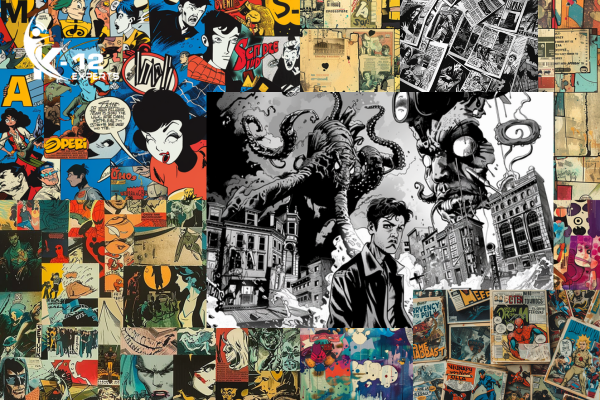
Discovering your muse for your first comic book hinges on exploring a vast array of genres and styles to find what truly clicks with you. Diving into this creative quest demands your time and energy, but when inspiration strikes, it’s like finding a secret passage in your favorite video game—exciting, unexpected, and profoundly rewarding.
Look around; your next great idea could be hiding in the quirkiest places—from the depths of your morning coffee cup to the eccentric neighbor with a penchant for midnight gardening. Keep a sketchbook handy; those random doodles could be the seeds of your comic universe.
Developing Characters
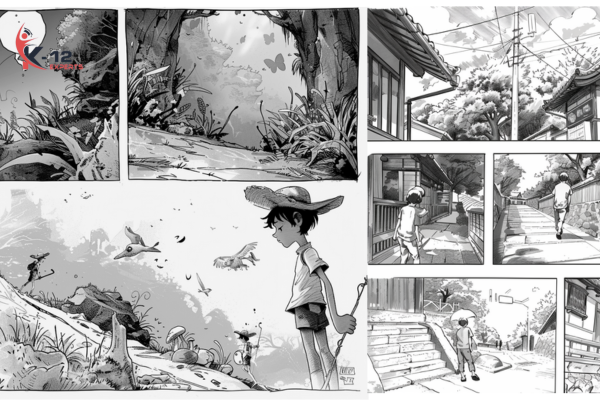
After discovering your inspiration, it’s time to immerse yourself in your comic by developing characters that captivate and resonate with readers. Crafting characters isn’t just a step; it’s an adventure that demands a lot of energy and might take a long time.
But hey, that’s what makes the ‘make my first comic book’ journey thrilling, right? Plunge into their worlds, exploring personalities, motivations, and backstories to add layers of depth. Sketching them out not only brings them to life visually but cements their traits in your mind.
Creating the Plot
Now that you’ve got your characters up and running, it’s time to throw them into the wild world of plot crafting.
Think of your theme as the compass guiding your story, ensuring every twist, turn, and tumble feels right at home.
With a bit of wit and a dash of daring, let’s set the stage for a tale that’ll keep your readers hooked ’til the very end.
Identifying Your Theme
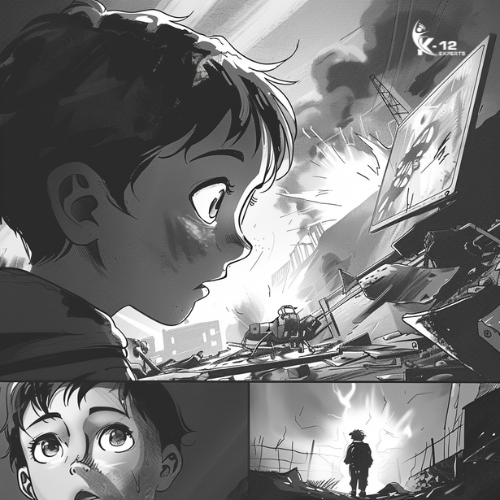
Identifying a compelling theme often serves as the backbone for crafting your comic book’s plot, guiding both character development and the storyline. A strong theme not only binds your story together but also resonates deeply with your audience, making your comic unforgettable. Let’s delve into the essentials of theme identification:
| Key Aspect | Why It Matters |
| Exploring Symbolism | Adds layers of meaning. |
| Understanding Subtext | Enhances the story’s depth. |
| Conveying Emotions | Connects with the reader’s heart. |
Developing Characters
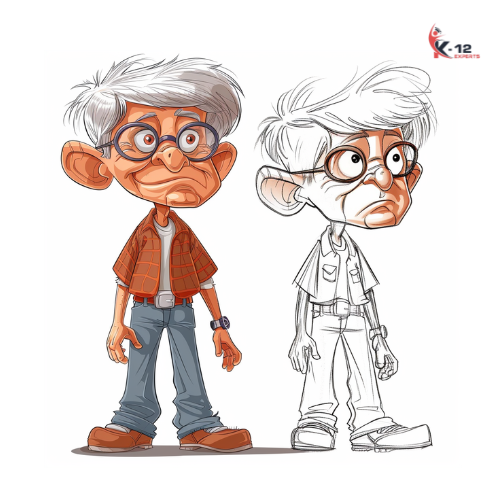
Having established a compelling theme, it’s time to breathe life into your comic by developing characters that embody and enrich your story. Crafting unique personalities, backgrounds, and motivations for each character is essential.
Imagine them not just as figures on a page but as living, breathing entities with their own quirks and tales. As they interact and face challenges, their relationships spark depth and conflict, making your narrative pop with intrigue. It’s like throwing a party where everyone’s secrets slowly unravel.
Guarantee their growth is consistent and believable; nobody likes a hero who suddenly turns a villain without reason. Well-rounded characters not only captivate but become unforgettable, embedding themselves in the hearts of your readers. Delve into this creative whirlpool and watch your characters flourish.
Designing the World
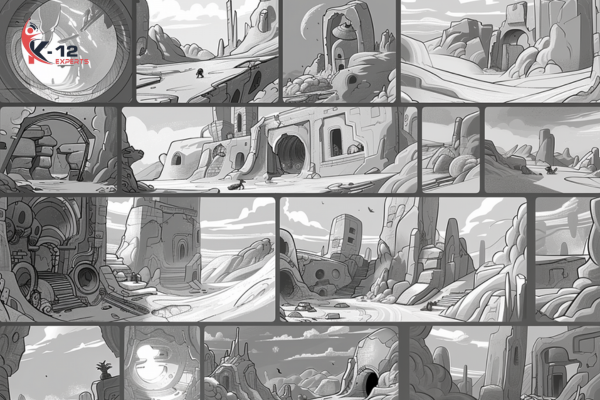
Before diving into the narrative of your comic book, it’s essential to design a vivid and cohesive world where your story unfolds. Here’s how to sprinkle some magic into your world-building cauldron:
| Element | Description | Tips |
| Setting & Time Period | Choose a unique setting and time period that breathes life into your narrative. | Avoid clichés. |
| Environment Details | Infuse your world with rich, immersive environment details to captivate readers. | Use vibrant color schemes. |
| Character Designs | Craft characters that embody the essence of your world. | Think outside the box. |
| Rules & Logic | Establish the laws of your universe for consistency. | Break rules wisely. |
| Background Elements | Insert subtle details to enrich the storytelling. | Keep it intriguing. |
Embrace these elements to create a world that tickles the imagination and pulls readers into a story they won’t want to leave.
Scriptwriting Techniques
Now that you’ve laid the groundwork for your comic world, it’s time to breathe life into it with your script. Crafting engaging dialogue isn’t just about making characters talk; it’s about making them speak in a way that’s so gripping that readers can’t help but hear their voices echo in their minds.
Structuring your narrative, on the other hand, is like building a rollercoaster—you’re in control of the ups, downs, and loop-de-loops that will have your audience clinging to the pages.
Crafting Engaging Dialogue
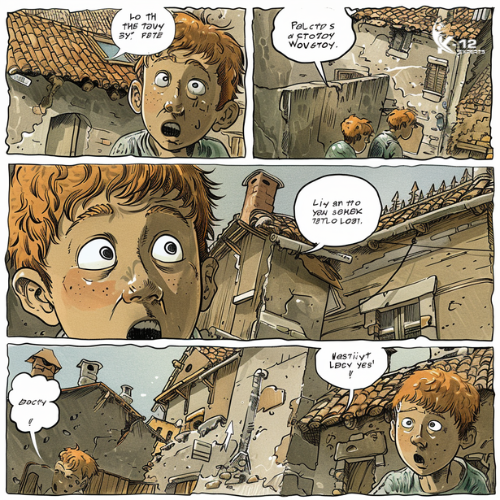
To craft engaging dialogue in your comic book, you must understand that it’s not only about what characters say but how they say it, reflecting their unique personalities and moving the story forward.
- Character dynamics: Let the interactions sizzle with tension, affection, and quirky banter.
- Emotional depth: Infuse conversations with feelings that tug at the heartstrings, making your heroes and villains deeply human.
- Natural flow: Mimic real-life chats, complete with interruptions, hesitations, and those oh-so-telling silences.
- Show, don’t tell: Rather than expositing, let your characters reveal secrets and backstories through what they say—or don’t.
Structuring Your Narrative
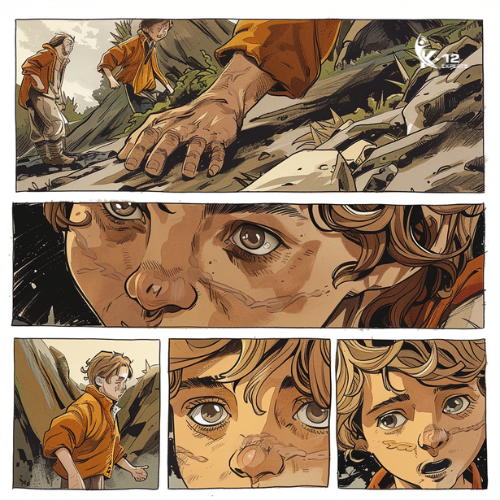
When embarking on your comic book journey, it’s crucial to structure your narrative attentively, utilizing scriptwriting techniques that bring vitality to your story.
Begin by crafting a storyline with a clear start, middle, and end, ensuring your comic flows seamlessly.
Immerse yourself in the heart of visual storytelling by using panel descriptions to paint vibrant scenes and actions.
Infuse your narrative with dialogue and captions that highlight character arcs and plot twists, adding layers of emotional depth.
Remember to experiment with pacing through panel sizes and layouts, creating climactic moments that captivate readers.
And, after all is said and done, polish your script to achieve conflict resolution, ensuring every word contributes to your masterpiece’s impact.
Drawing Basics
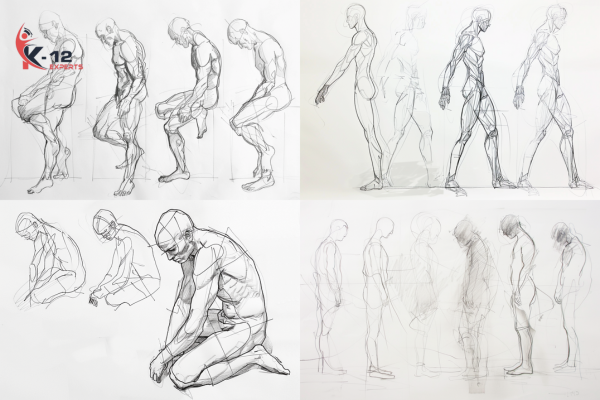
Mastering drawing basics is essential for crafting compelling characters and immersive environments in your comic book. To kick off your artistic adventure, consider these key elements:
- Line variation, shading: From bold, dramatic lines to soft, subtle shading, learn to use these to add depth and emotion.
- Shape practice, proportions: Get cozy with circles, squares, and triangles. They’re the secret sauce to nailing those tricky proportions.
- Tools exploration: Pencils, pens, brushes, oh my! Each has its own magic to bring your visions to life.
- Anatomy understanding: Because knowing how to draw a convincing superhero pose is pretty cool, right?
Dive into these basics, and you’ll be sketching up a storm of engaging stories and worlds in no time!
Coloring and Inking
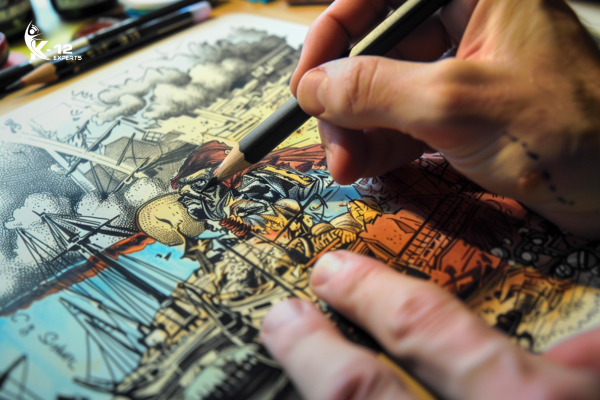
After mastering drawing basics, diving into coloring and inking is your next step to bring your comic book’s illustrations to life with depth and dimension. Inking outlines your art with precision, setting the stage for the magic of colors. Whether you’re wielding markers or clicking away digitally, blending colors and mastering shading techniques will transform flat sketches into dynamic storytelling.
| Traditional Coloring | Digital Coloring |
| Tangible texture | Infinite colors |
| Hands-on experience | Undo button |
| Unique outcomes | Layer magic |
| Marker blending | Gradients galore |
| Time-consuming | Efficient |
Embrace the journey of digital vs traditional coloring, where each stroke adds emotion and every shade tells a story. It’s not just about filling spaces; it’s about crafting worlds.
Lettering Your Pages
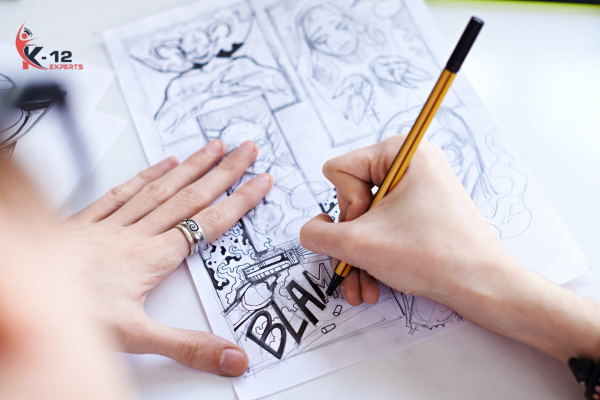
Diving into the world of lettering, you’ll find that choosing the right fonts and styles is essential for bringing your comic book’s dialogue and sound effects to life. Here’s how to make your words leap off the page:
- Font selection: Pick fonts that match your comic’s tone—spooky tales deserve creepy lettering!
- Consistency practice: Keep your style uniform. It’s like handwriting but cooler.
- Text placement: Strategically place dialogue to lead the reader’s eye and not cover your art’s best bits.
- Balancing act: Mix text and images without turning your page into a crowded subway train.
Publishing Options
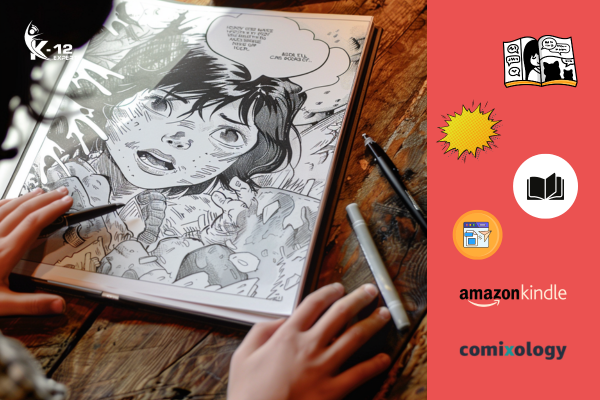
Once you’ve polished your comic book, exploring your publishing options is the next essential step. Diving into the world of self-publishing through online platforms like Comixology or Amazon Kindle Direct Publishing, you’ll wield full creative control, a dream for the innovatively inclined.
Traditional publishing isn’t left in the dust, though; it offers a wider stage for your comic, amplifying your marketing strategies and distribution channels. Ever thought of rallying a fanbase before release? Crowdfunding benefits on Kickstarter or Indiegogo can turn those dreams into tangible pages, with supporters fueling your project.
And if you’re a fan of the phrase ‘print only what you need,’ print-on-demand services are your new best friend, reducing those challenging upfront costs. Don’t forget teaming up with local indie shops can sprinkle a bit of magic, connecting your mini-comics directly with enthusiasts.
Frequently Asked Questions
How Do You Make a Comic Book for Beginners?
To make a comic book, start by sketching character designs and outlining your story. Use storyboarding techniques to plan scenes. Embrace digital tools for drawing and editing, ensuring your comic’s innovative and visually compelling.
How Can a Kid Make a Simple Comic Book?
To make a simple comic book, you’ll need character design, drawing tools, and story inspiration. Start by sketching your characters, then use pencils and markers to bring your story to life on paper.
What Are the 5 Elements of Comic?
In comics, you’ve got five key elements: characters, setting, plot, conflict, and theme. Focus on character design, master visual storytelling, and nail your panel layout to bring your innovative ideas to life through each page.
How Do You Start the First Page of a Comic Book?
To start your comic’s journey, immerse yourself in creating a compelling page layout, introducing your characters artfully, and selecting an art style that hints at your tale. This initial blueprint sets the stage for innovation.
Conclusion
So, you’ve journeyed through the whimsical world of comic creation, from the spark of inspiration to the final flourish of ink and color. Who knew that the path from dreaming to drawing could be so captivating?
As you stand at the brink of sharing your masterpiece, remember, each page holds a piece of your imagination, daring to leap into the hands of enthusiastic readers.
Now, isn’t it exciting to think of the worlds you’ll create next? Keep sketching, dreaming, and chuckling along the way!

